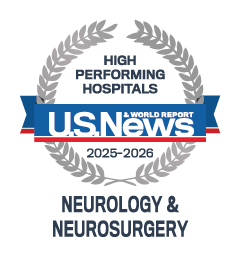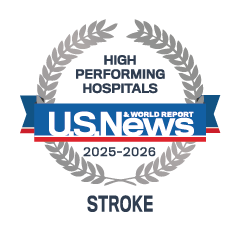Tampa General Hospital’s Neuroscience Institute is a nationwide leader in treating complex neurological conditions. This includes subarachnoid hemorrhages (SAHs), or bleeding in the space between the brain and its surrounding protective membranes. A subarachnoid hemorrhage occurs when a blood vessel on the brain’s surface ruptures and leaks, causing pressure buildup that can lead to permanent disability or death if left untreated.
Subarachnoid Hemorrhage Causes
An aneurysm—or a weak area of a blood vessel that bursts—is a common cause of subarachnoid hemorrhage. Other factors that may result in SAH include head trauma, blood vessel malformations, bleeding disorders, drug use or excessive alcohol consumption, and taking blood thinners.
Anyone can experience a subarachnoid hemorrhage. However, this condition is most likely to affect:
- Adults between the ages of 40 and 60
- Smokers
- People with high blood pressure (hypertension)
- People with a personal or family history of aneurysms
Subarachnoid Hemorrhage Symptoms
The signature symptom of a subarachnoid hemorrhage is a sudden intense “thunderclap” headache. This excruciating headache may be accompanied by:
- A stiff neck
- Loss of consciousness
- Dizziness or confusion
- Seizures
- Nausea and/or vomiting
- Increased sensitivity to light
- Sudden vision changes, such as blurriness or double vision
- Unexplained weakness
- Muscle aches that may affect the shoulders and neck
- Numbness in one area of the body
Call 911 immediately or go to the nearest Emergency Department if you or someone around you experiences possible signs of a subarachnoid hemorrhage.
Subarachnoid Hemorrhage Diagnosis
An emergency department will likely evaluate an individual with a subarachnoid hemorrhage. Medical professionals will work quickly to identify the cause of symptoms and pinpoint the location and cause of the brain bleeding. Multiple tests may be used in the diagnostic process, including:
Subarachnoid Hemorrhage Treatments
Subarachnoid hemorrhage treatment focuses on relieving pressure in the brain, repairing the aneurysm (if present) and preventing complications. Because SAH is life-threatening, initial treatment typically involves emergency procedures such as catheter-based or open surgical approaches to stop the bleeding.
TGH’s Neuroscience Institute performs more neurosurgeries than any other regional hospital. Incorporating leading-edge technologies into daily practice, our neurologists and neurosurgeons collaborate with specialists throughout TGH to deliver well-rounded, world-class care to our patients.
Why Choose TGH's Comprehensive Stroke Center
Call 911 immediately or go to the nearest Emergency Department if you or someone around you experiences possible signs of a subarachnoid hemorrhage. For non-emergent situations, contact the Tampa General Hospital’s Neuroscience Institute at (855) 566-3627 to schedule an appointment or learn more about our advanced approach to subarachnoid hemorrhages. Tampa General Hospital was named in the Top 10% in the Nation for Neurology & Neurosurgery and High Performing for Stroke Care, according to U.S. News & World Report for 2025-26. Additionally, Newsweek ranked TGH as the #1 hospital in Tampa and West Central Florida for Cardiac Care for 2025.


